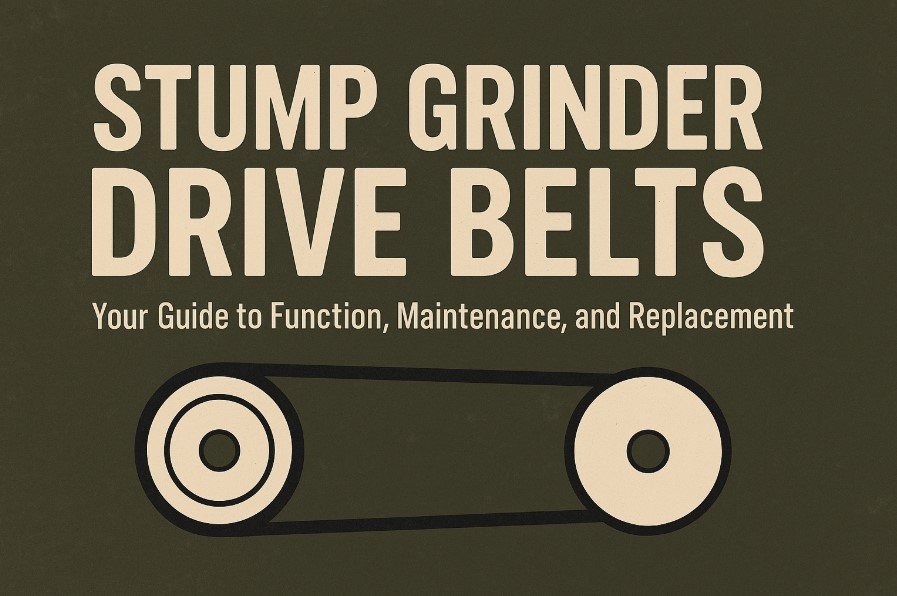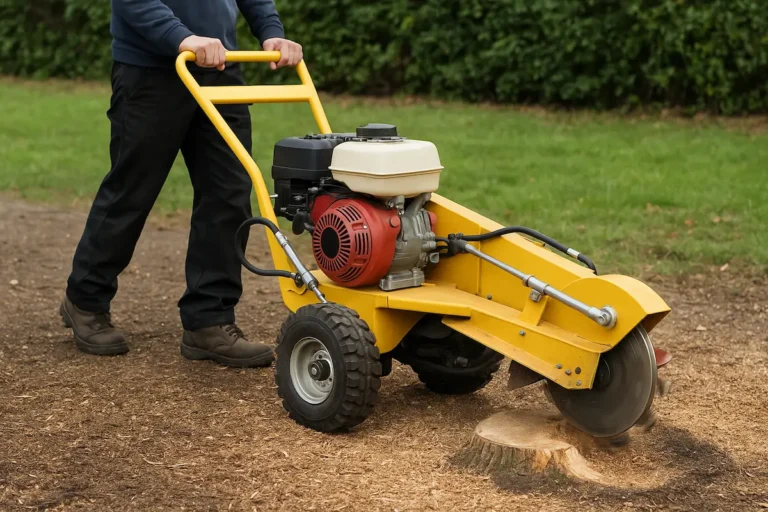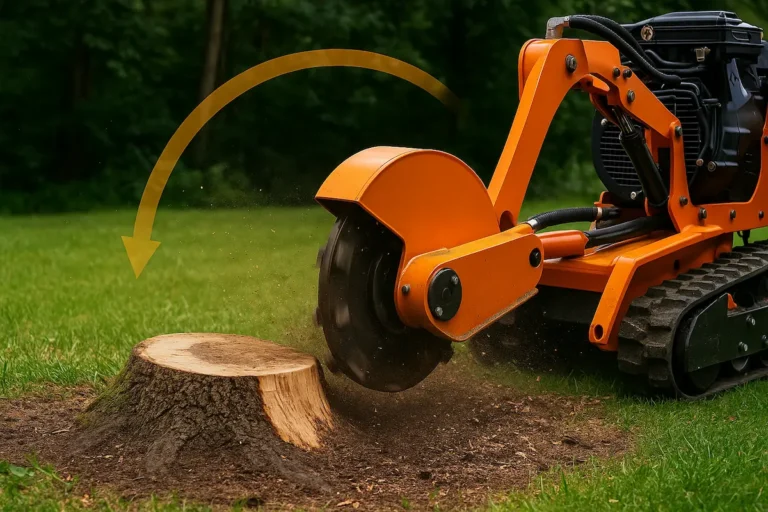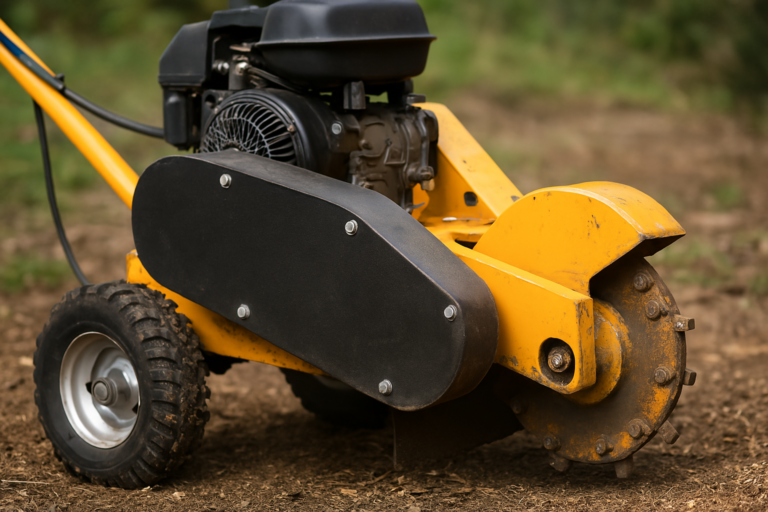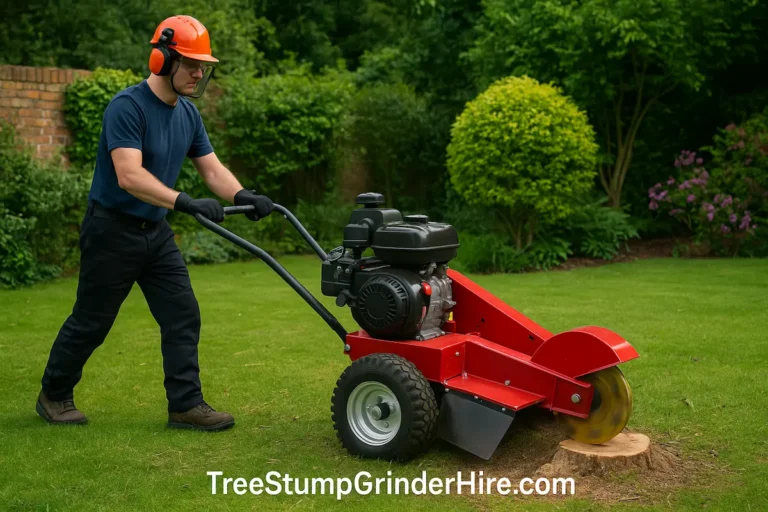Stump Grinder Drive Belts: Your Guide to Function, Maintenance, and Replacement
Stump grinder drive belts are super important.
They send power from the engine to the cutting wheel.
Keeping them working stops problems and saves time.
This guide explains everything you need to know.
Key Takeaways: Common Stump Grinder Belt Issues
- The chart highlights the relative importance and commonality of different drive belt problems based on the provided guide.
- Belt Slipping is presented as the most frequently emphasized issue, often caused by incorrect tension or wear, leading to power loss and potential damage.
- Excessive Wear (cracks, fraying, glazing) is also significant, indicating the need for regular visual inspections.
- While less frequent or less emphasized than slipping, Belt Breaking represents a critical failure causing immediate downtime.
- Noise (squealing/chirping) serves as a common auditory warning sign, often linked to tension or alignment problems.
- Overall, proactive maintenance, especially regular tension checks and inspections, is crucial for preventing these common problems.
Understand Why Your Stump Grinder Drive Belt is Vital
The drive belt is a key part of your stump grinder.
It connects the engine to the part that grinds the stump.
Without it, the grinder won’t work.
It does several critical jobs.
Transmit Engine Power to the Cutting Wheel
The engine makes power by spinning.
The drive belt takes this spinning power.
It sends the power to the cutting wheel assembly.
This makes the cutting wheel spin very fast.
The fast wheel can then grind up tough tree stumps.
Think of it like the chain on a bicycle.
It takes power from your legs to the back wheel.
The drive belt does the same for the grinder’s cutter.
Engage and Disengage Power (Clutch Function)
Many grinders use belts with a clutch system.
A clutch helps control when the cutter wheel spins.
The engine needs to reach a certain speed first.
Then, the clutch tightens the drive belts.
Tight belts grip the pulleys well.
This grip makes the cutting wheel start spinning.
When the engine slows down, the clutch releases.
The belts loosen slightly.
The cutting wheel stops spinning.
This makes starting the grinder safer.
It also controls the grinding action.
The belts are a core part of this on/off system.
Absorb Shock Loads During Grinding
Grinding stumps is challenging work.
Sometimes, the cutter wheel hits hard things.
It might hit a hidden rock or very dense wood.
This causes a sudden jolt or shock.
The drive belts can help soften this shock.
They might slip a little bit.
Or they might stretch for a moment.
This little bit of giving protects other parts.
It can stop the engine or gears from breaking.
Too much slipping is terrible, but a little helps absorb hits.
It acts like a small cushion in the system.
Recognise Common Stump Grinder Belt Problems (Symptoms & Causes)
Drive belts wear out over time.
They can develop problems that stop the grinder from working well.
Knowing the signs helps you fix things quickly.
Here are the most common issues.

Identify Belt Slipping: Loss of Power, Squealing, and Burning Smells
Belt slipping is a widespread problem.
You will notice the grinder is not cutting well.
The engine might sound fast, but the wheel is slow.
This means the grinder loses cutting power.
You might hear a loud, squealing noise.
This often happens when the belt slips on the pulley.
Sometimes, you can smell burning rubber.
This happens when the slipping belt gets very hot.
The surface of the belt might look shiny or glazed.
What causes slipping?
- Not enough TensionTension: The belt is too loose (the most common reason).
- Worn belts: Old belts lose their grip.
- Glazed belts: Slipping makes the belt surface hard and shiny.
- Oil or grease: Contamination makes belts slippery.
- Wrong belt: Using the incorrect size or type.
- Pulleys not lined up: Misalignment causes uneven contact.
“Learned the hard way to check belt tension every single day. I had a belt slip and glaze over mid-job on a big stump. Lost an hour having to run out and buy a replacement because the glazed one wouldn’t grip anymore.” – Quote from an ArboristSite forum user.
Address a Snapped or Broken Drive Belt
Sometimes, a drive belt can break completely.
You will know immediately because the cutter wheel stops spinning.
All power to the wheel is lost suddenly.
You might hear a loud snapping sound when it breaks.
Why do belts break?
- Old Age: Belts get weak over time and fail.
- Big shocks: Hitting a large rock or concrete can snap a belt.
- Debris: Stones or wood chips getting caught can break it.
- Bad alignment: Pulleys not being straight puts stress on the belt.
- Too tight: Over-tightening can strain the belt too much.
- Contamination: Oil or chemicals can weaken the belt material.
Keeping spares is a good idea, especially for demanding jobs.
“My grinder… eats belts if I hit rocks too often. The shock load seems to shred them eventually. I keep two spares now.”” – Observation from a YouTube comment.
Spot Belt Wear: Cracks, Fraying, and Glazing
Belts wear down with regular use.
You need to check them often for signs of damage.
Look closely at the belt surface.
Check the underside for small cracks.
Look at the edges for any fraying or loose threads.
See if any chunks of rubber are missing.
Check if the surface looks glazed (shiny and hard).
What causes this wear?
- Everyday use: Belts are parts that wear out and need replacing.
- Misalignment: Pulleys not lined up cause wear on one side.
- Wrong TensionTension: Too loose or too tight causes extra stress.
- Harsh conditions: Dirt and heat can speed up wear.
Regular checks help you spot wear before the belt fails.
Diagnose Belt Squealing and Chirping Noises
Loud noises often mean a belt problem.
Squealing or chirping sounds are common clues.
The noise might happen when starting up.
It might happen when the grinder is cutting hard.
What causes belt noise?
- Wrong TensionTension: Usually too loose, but sometimes too tight.
- Misalignment: Pulleys not being straight.
- Worn pulleys: Grooves in the pulley might be damaged.
- Glazed belt: A shiny, hard belt surface slips and squeals.
Belt dressing spray can sometimes quieten a belt temporarily.
But it often means the belt needs adjusting or replacing soon.
Visual Summary: Common Drive Belt Problems
Visual Summary: Common Drive Belt Problems
| Problem | Symptoms | Common Causes |
|---|---|---|
| Belt Slipping | Loss of power, squealing, burning smell, glazed belt | Low tension, worn belt, contamination, wrong belt, misalignment |
| Belt Breaking | Sudden power loss, snapping sound | Age, shock loads, debris, misalignment, over-tensioning |
| Excessive Wear | Cracks, fraying, glazing, chunks missing | Normal use, misalignment, wrong tension, environment |
| Noise | Squealing, chirping | Wrong tension, misalignment, worn pulleys, glazed belt |
Perform Essential Drive Belt Maintenance for Longevity
You can make your drive belts last longer.
Good maintenance prevents many common problems.
It keeps your stump grinder working reliably.
Here are the key maintenance steps.
Prioritise Checking Belt Tension Regularly (Daily/Pre-Use)
Belt tension is how tight the belt is.
Checking TensionTension is the most critical maintenance job.
Do this check very often.
Many makers suggest checking every 8-10 hours of use.
For hired machines, check before every single use.
Why is correct TensionTension so vital?
- Too loose: The belt will slip, lose power, get hot, and glaze over.
- Too tight: Puts too much strain on belts, bearings, and shafts. This can cause parts to break.
Finding the sweet spot for TensionTension is key.
Always follow the grinder manufacturer’s guide.
Learn How to Tension Your Grinder Belt Correctly
How you adjust TensionTension depends on the machine.
Read your grinder’s manual carefully.
Often, you need to move the engine slightly.
Or adjust an idler pulley wheel.
Some machines have special tensioning bolts or screws.
Manufacturers usually specify how tight the belt should be.
They measure this by deflection.
This means pushing on the belt in the middle.
You measure how much the belt moves (deflects).
For example, the manual might say, “1/2 inch deflection with 5 lbs force”.
Some grinders have built-in tension indicators to help.
Never guess the TensionTension; use the official guide.
Getting it right saves belts and prevents damage.
Conduct Regular Visual Belt Inspections
Look at your belts before you start work.
Make it part of your daily routine.
Take off the safety guards if needed (engine OFF!).
Look for any cracks, especially on the inner side.
Check for fraying along the edges.
Look for glazing (shiny spots).
Check for oil, grease, or caked-on dirt.
Make sure the belt guards are in place.
Ensure guards are not bent or full of debris.
Clean out any wood chips or dirt near the belts.
This quick check can spot trouble early.
Maintain a Clean Belt Drive Area
Dirt and debris are enemies of drive belts.
Wood chips, mud, stones, and twigs can get caught.
Debris between the belt and pulley causes damage.
It can make a belt jump off the pulley.
It can even cause a belt to snap.
Keep the area around the belts and pulleys clean.
Make sure belt guards are fitted correctly.
They help keep debris out.
Clear out any build-up regularly.
A clean machine works better and lasts longer.
Check for Proper Pulley Alignment
The pulleys are the wheels the belt runs on.
One pulley is on the engine shaft.
The other is on the cutter wheel shaft.
These pulleys must line up perfectly straight.
If they are crooked (misaligned), the belt wears unevenly.
One edge of the belt might wear out fast.
Misalignment puts extra stress on the belt.
It can lead to premature failure.
Checking alignment is usually a job for a mechanic.
But be aware if belts are always worn on one side.
It might signal an alignment problem.
Know When and How to Replace the Drive Belt
Even with reasonable care, belts wear out.
They are consumable parts, like brake pads on a car.
You need to know when to change them.
Using the correct replacement is also vital.
Determine When to Replace Your Belt
Replace the belt if you see clear signs of failure.
- Visible Damage: Obvious cracks, deep cuts, frayed edges, missing chunks.
- Glazing: If the belt surface is gleaming and hard to slip. Even if tensioned, it might not grip properly.
- Persistent Slipping: If the belt keeps slipping even after correct tensioning.
- Breakage: If the belt snaps, you must replace it.
Do not wait for a belt to fail mid-job.
If it looks very worn, replace it proactively.
This saves time and hassle later.
Select the Correct Replacement Belt Type (V-Belts, Banded, Cogged)
You must use the correct drive belt for your grinder.
Using the wrong size or type will cause problems.
It might slip, wear out quickly, or just not fit.
Check your grinder’s manual or parts list.
It will specify the exact belt needed.
Common types found on stump grinders:
- V-Belts: Most common type. Shaped like a ‘V’ to wedge into the pulley groove. Sometimes single, sometimes multiple belts side-by-side.
- Banded V-Belts: Multiple V-belts joined together at the top by a band. Used on bigger grinders for more power. The band stops belts from twisting or jumping off.
- Cogged V-Belts: These have notches or teeth on the underside. They bend more easily around small pulleys. They can sometimes run cooler.
Always use the belt type recommended by the manufacturer.
Get the exact part number if possible.
Buy from reputable dealers or manufacturers.
Understand the Costs of Drive Belt Replacement
Replacing a drive belt has a cost.
The belt itself is not usually costly.
Prices range depending on size and type.
- Smaller grinder belts: Maybe £20 to £50.
- Large, banded belts for commercial machines: Could be £100 to £150+.
However, consider the cost of not replacing a worn belt.
A failed belt means downtime.
You lose working time, which costs money.
If hiring, you lose valuable rental time.
A slipping or snapping belt could damage other parts.
Replacing a clutch or bearing is much more expensive.
Spending £50 on a new belt is cheaper than hours of lost work.
Proactive replacement saves money in the long run.
Follow Best Practices for Belt Replacement
When changing a belt, do it correctly.
Always turn the engine OFF and disconnect the spark plug.
Loosen the tension mechanism properly.
Never try to force or pry a new belt onto the pulleys.
This can damage the belt cords inside.
Slide the old belt off and the new belt on gently.
Ensure the belt sits correctly in the pulley grooves.
Re-tension the new belt according to the manual.
New belts might need re-tensioning after a short run-in period.
Recheck the TensionTension after the first hour of use.
Put all safety guards back securely before starting.
Consider Drive Belt Issues When Hiring a Stump Grinder
If you hire a stump grinder, belt condition matters.
A machine with a bad belt will cause frustration.
Know what to look for and what to expect.
Recognise Signs of Belt Problems on Hire Equipment
Before you take the grinder away, check it over.
Ask the hire company about belt checks.
When you start using it, pay attention.
Listen for unusual squealing noises.
Feel if the cutting power seems low or drops off.
Smell for any burning rubber odours.
If you notice these signs, stop using it immediately.
Contact the hiring company immediately.
Do not try complex repairs yourself on hire gear.
But knowing the signs helps you report the issue.
This ensures you get a working machine quickly.
Understand the Hirer’s Responsibility vs. Hire Company
The hire company should maintain the grinder well.
This includes checking belts before each hire.
They should ensure belts are in good condition and tensioned.
Your responsibility as the hirer is to use it correctly.
Avoid hitting obvious obstacles like large rocks.
Report any problems like power loss or noise promptly.
Basic checks, like looking for apparent damage, are sensible.
Do not ignore warning signs.
Clear communication helps resolve issues quickly.
Learn from Real-World Stump Grinder Experiences
Hearing from others helps us understand belt issues better.
Online forums and videos share helpful tips.
Key takeaways from experienced users:
- Check TensionTension Daily: This is the most repeated advice. It prevents most slipping issues.
- Keep Spares: Especially for commercial users, having spare belts on hand saves enormous downtime.
- Prevention is Cheaper: Replacing a worn belt before it fails saves time and avoids mid-job stress.
- Listen to Your Machine: Noises often mean something needs attention. Don’t ignore squeals.
- Debris is Bad: Users report belts failing after sucking in stones or wood chunks. Keep the area clean.
Example Scenario (Based on standard reports):
A weekend hirer rents a grinder from treestumpgrinderhire.com.
It works fine on Saturday.
Sunday morning, it lacks power and smells burnt.
The hirer calls the company.
Based on the smell and power loss, a belt issue is likely.
Maybe the belt slipped and glazed over.
Or perhaps debris got caught and damaged it.
This situation causes delay and frustration for the hirer.
It highlights why pre-hire checks are so necessary.
Impact of Belt Condition on Hire Businesses (e.g., treestumpgrinderhire.com)
For a hire business, drive belt reliability is crucial.
Belt problems directly affect customers and the business of grinding tree stumps.
Minimise Customer Downtime and Complaints
Customers hire grinders to get a job done efficiently.
A belt failure stops them from working.
This leads to complaints and unhappy customers.
Well-maintained belts mean reliable machines.
Reliable machines lead to satisfied customers.
Protect Your Business Reputation
Word spreads quickly about equipment reliability.
If hire machines constantly break down, reputation suffers.
Customers will go elsewhere next time.
Good maintenance, including belt care, builds trust.
It shows professionalism and care for the customer.
Manage Maintenance Costs Effectively
Drive belts are a regular maintenance cost.
Replacing them before they fail is thoughtful planning.
Emergency replacements cost more in terms of time and logistics.
Neglecting belts can lead to damage elsewhere (clutches, bearings).
Tracking belt life helps schedule preventative maintenance.
This makes costs more predictable.
Enhance Operational Safety
A belt snapping unexpectedly can be a hazard.
While guards should contain it, sudden power loss can be risky.
A grinder behaving predictably is safer to operate.
Ensuring belts are in good shape contributes to overall safety.
Actionable Advice for Reliable Stump Grinding
Keep your stump grinder’s drive belt in top shape.
Follow these simple steps for better performance.
- Check TensionTension often: Before each use or daily. Use manufacturer specs.
- Inspect visually: Look for cracks, fraying, or glazing regularly.
- Please keep it clean: Prevent debris build-up around belts and pulleys.
- Use the right belt: Always replace it with the exact OEM-specified belt.
- Replace proactively: Change belts showing significant wear before they fail.
- Listen and feel: Pay attention to noises or power loss during operation.
For hire companies like treestumpgrinderhire.com, strict checks are vital.
Good belt maintenance means happy customers and reliable equipment.
Need to hire a reliable stump grinder?
✅ Need a reliable grinder with belts already checked and tensioned?
Browse trusted listings now at treestumpgrinderhire.com — your source for well-maintained hire machines across the UK.

